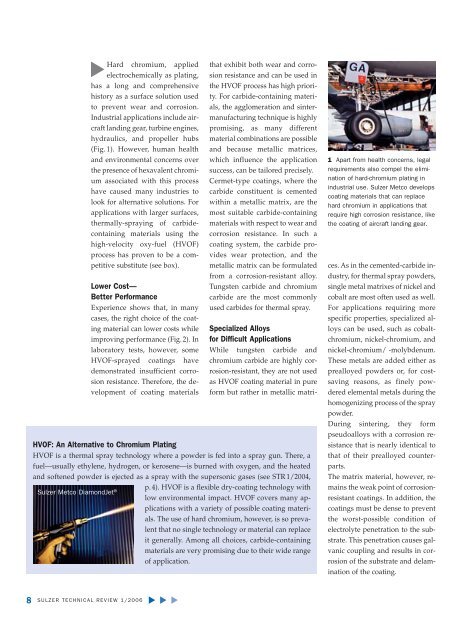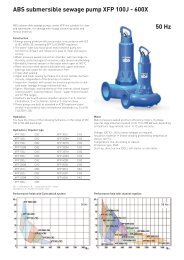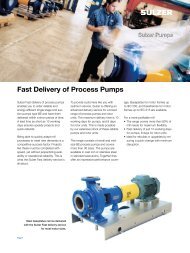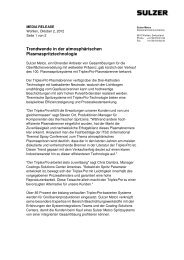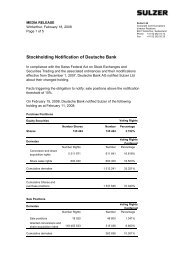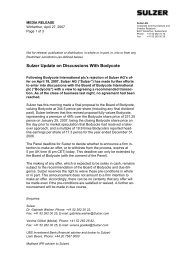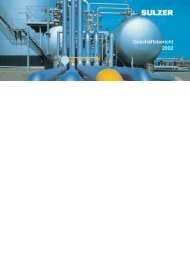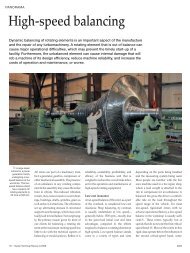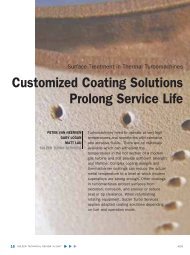Hvof-Sprayed Materials Replace Hard-Chromium Plating
Hvof-Sprayed Materials Replace Hard-Chromium Plating
Hvof-Sprayed Materials Replace Hard-Chromium Plating
Erfolgreiche ePaper selbst erstellen
Machen Sie aus Ihren PDF Publikationen ein blätterbares Flipbook mit unserer einzigartigen Google optimierten e-Paper Software.
8<br />
<strong>Hard</strong> chromium, applied<br />
electrochemically as plating,<br />
has a long and comprehensive<br />
history as a surface solution used<br />
to prevent wear and corrosion.<br />
Industrial applications include aircraft<br />
landing gear, turbine engines,<br />
hydraulics, and propeller hubs<br />
(Fig. 1). However, human health<br />
and environmental concerns over<br />
the presence of hexavalent chromium<br />
associated with this process<br />
have caused many industries to<br />
look for alternative solutions. For<br />
applications with larger surfaces,<br />
thermally-spraying of carbidecontaining<br />
materials using the<br />
high-velocity oxy-fuel (HVOF)<br />
process has proven to be a competitive<br />
substitute (see box).<br />
Lower Cost—<br />
Better Performance<br />
Experience shows that, in many<br />
cases, the right choice of the coating<br />
material can lower costs while<br />
improving performance (Fig. 2). In<br />
laboratory tests, however, some<br />
HVOF-sprayed coatings have<br />
demonstrated insufficient corrosion<br />
resistance. Therefore, the development<br />
of coating materials<br />
SULZER TECHNICAL REVIEW 1/2006<br />
that exhibit both wear and corrosion<br />
resistance and can be used in<br />
the HVOF process has high priority.<br />
For carbide-containing materials,<br />
the agglomeration and sintermanufacturing<br />
technique is highly<br />
promising, as many different<br />
material combinations are possible<br />
and because metallic matrices,<br />
which influence the application<br />
success, can be tailored precisely.<br />
Cermet-type coatings, where the<br />
carbide constituent is cemented<br />
within a metallic matrix, are the<br />
most suitable carbide-containing<br />
materials with respect to wear and<br />
corrosion resistance. In such a<br />
coating system, the carbide provides<br />
wear protection, and the<br />
metallic matrix can be formulated<br />
from a corrosion-resistant alloy.<br />
Tungsten carbide and chromium<br />
carbide are the most commonly<br />
used carbides for thermal spray.<br />
Specialized Alloys<br />
for Difficult Applications<br />
While tungsten carbide and<br />
chromium carbide are highly corrosion-resistant,<br />
they are not used<br />
as HVOF coating material in pure<br />
form but rather in metallic matri-<br />
Sulzer Metco DiamondJet ®<br />
HVOF: An Alternative to <strong>Chromium</strong> <strong>Plating</strong><br />
HVOF is a thermal spray technology where a powder is fed into a spray gun. There, a<br />
fuel—usually ethylene, hydrogen, or kerosene—is burned with oxygen, and the heated<br />
and softened powder is ejected as a spray with the supersonic gases (see STR 1/2004,<br />
p. 4). HVOF is a flexible dry-coating technology with<br />
low environmental impact. HVOF covers many applications<br />
with a variety of possible coating materials.<br />
The use of hard chromium, however, is so prevalent<br />
that no single technology or material can replace<br />
it generally. Among all choices, carbide-containing<br />
materials are very promising due to their wide range<br />
of application.<br />
1 Apart from health concerns, legal<br />
requirements also compel the elimination<br />
of hard-chromium plating in<br />
industrial use. Sulzer Metco develops<br />
coating materials that can replace<br />
hard chromium in applications that<br />
require high corrosion resistance, like<br />
the coating of aircraft landing gear.<br />
ces. As in the cemented-carbide industry,<br />
for thermal spray powders,<br />
single metal matrixes of nickel and<br />
cobalt are most often used as well.<br />
For applications requiring more<br />
specific properties, specialized alloys<br />
can be used, such as cobaltchromium,<br />
nickel-chromium, and<br />
nickel-chromium/ -molybdenum.<br />
These metals are added either as<br />
prealloyed powders or, for costsaving<br />
reasons, as finely powdered<br />
elemental metals during the<br />
homogenizing process of the spray<br />
powder.<br />
During sintering, they form<br />
pseudoalloys with a corrosion resistance<br />
that is nearly identical to<br />
that of their prealloyed counterparts.<br />
The matrix material, however, remains<br />
the weak point of corrosionresistant<br />
coatings. In addition, the<br />
coatings must be dense to prevent<br />
the worst-possible condition of<br />
electrolyte penetration to the substrate.<br />
This penetration causes galvanic<br />
coupling and results in corrosion<br />
of the substrate and delamination<br />
of the coating.


